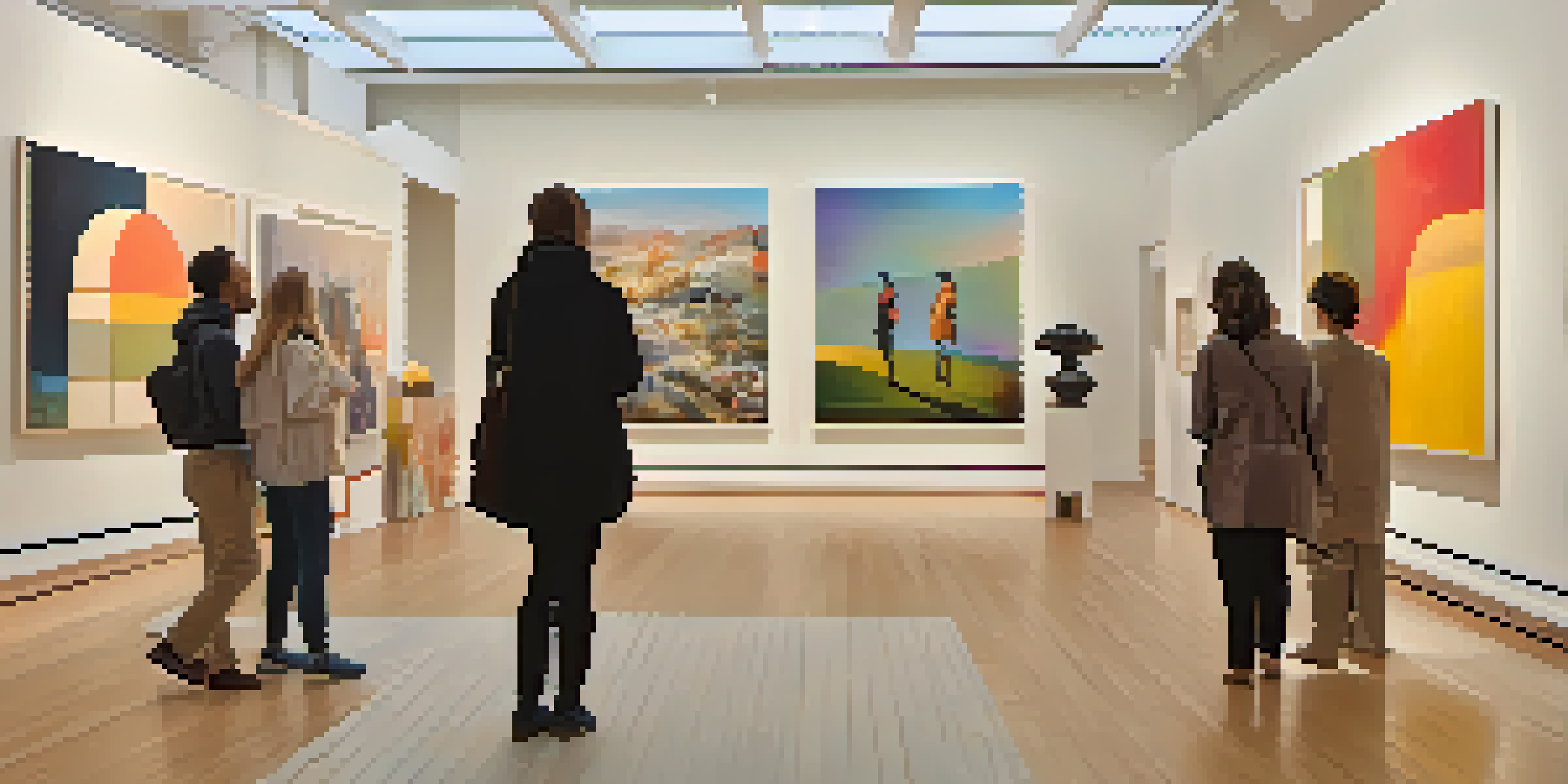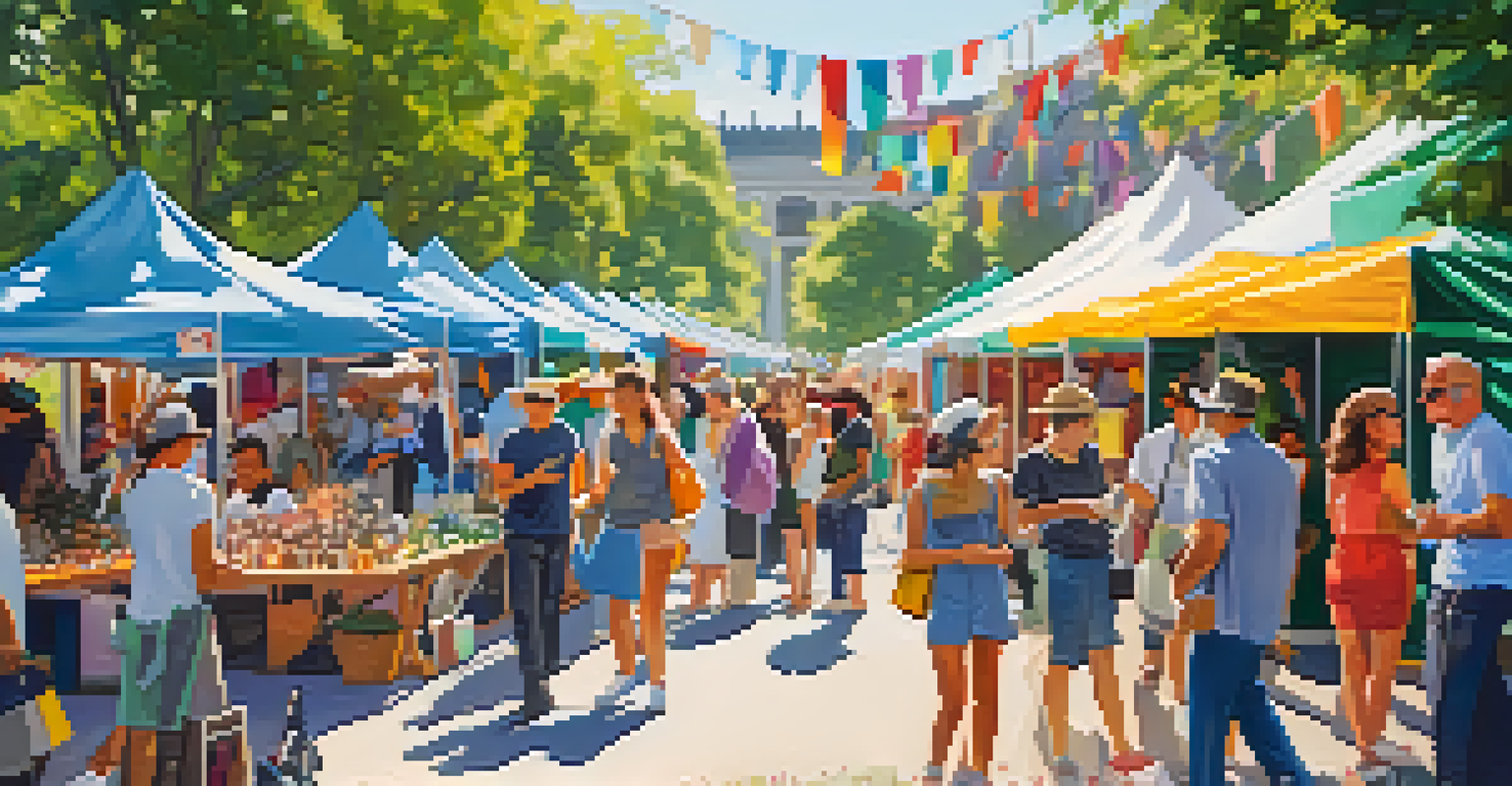Galleries and Their Role in Shaping Art Market Dynamics

Understanding the Role of Art Galleries in the Market
Art galleries serve as the vital link between artists and buyers, shaping how art is perceived and valued. They showcase artists' works, providing a platform for exposure and engagement. By curating exhibitions, galleries influence trends and can elevate certain styles or movements, creating a ripple effect in the market.
Art is not what you see, but what you make others see.
Additionally, galleries often take on the role of advisors, guiding collectors in their purchases and helping them navigate the sometimes overwhelming world of art. This relationship not only enhances the buyer's experience but also builds a community around the artists they represent. Through these interactions, galleries play a critical role in establishing an artist's reputation.
Moreover, galleries often participate in art fairs and exhibitions, further promoting their artists on a global stage. This exposure can significantly impact an artist's career trajectory, leading to increased demand and higher prices for their work. In this way, galleries are not just venues for art, but strategic players in the broader art market economy.
The Impact of Galleries on Artists' Careers
For many artists, aligning with a gallery can be a turning point in their career. Galleries provide essential resources such as marketing, branding, and exhibition opportunities, which are crucial for an artist's growth. This partnership allows artists to focus on their creativity while the gallery handles the business side of things.

In addition to providing exposure, galleries can significantly impact an artist's pricing strategy. Through their expertise and market knowledge, galleries help set appropriate price points based on demand, quality, and market trends. This can sometimes lead to a rapid increase in an artist's value, benefiting both the artist and the gallery.
Galleries Connect Artists and Buyers
Art galleries serve as crucial intermediaries, providing artists with exposure and guidance while helping collectors navigate the art market.
Furthermore, galleries often have established networks of collectors, critics, and curators that artists might not access independently. This connection can lead to solo exhibitions, inclusion in prestigious collections, and invitations to participate in significant art events, all of which contribute to an artist's visibility and credibility.
How Galleries Influence Art Market Trends
Art galleries are key influencers when it comes to setting market trends. By curating specific styles or themes in their exhibitions, they can shape what is considered fashionable or relevant in the art world. This influence extends to the types of art that collectors seek and invest in, ultimately impacting the entire market.
A gallery is a place where art and people can meet, creating a dialogue that transcends words.
Moreover, galleries often collaborate with artists to create limited editions or unique pieces, which can drive demand and create a sense of exclusivity. This strategy not only highlights the gallery's role in promoting artists but also establishes a competitive edge in the market. Collectors may rush to acquire these pieces, knowing their value may appreciate over time.
The interplay between galleries and market trends also reflects broader societal changes. For instance, galleries may highlight social issues or movements through their exhibitions, responding to public interest and concern. This connection between art and society makes galleries vital in shaping not just the art market, but cultural conversations at large.
The Financial Aspects of Running an Art Gallery
Operating an art gallery involves navigating complex financial dynamics. Galleries typically take a commission from the sale of artworks, which can range from 30% to 50%. This business model means that galleries need to balance showcasing emerging artists while maintaining profitability on established names.
In addition to commissions, galleries often face significant overhead costs, including rent, utilities, and staffing. These expenses can be daunting, especially for smaller galleries that may not have a robust client base. As a result, many galleries diversify their revenue streams by hosting events, workshops, or offering art consultancy services.
Galleries Shape Market Trends
By curating exhibitions and showcasing specific styles, galleries influence what is considered fashionable in the art world, impacting collector demand.
The financial health of a gallery can directly affect the artists they represent. A successful gallery can lead to increased sales and visibility for artists, while financial instability can hinder opportunities for everyone involved. Therefore, understanding the financial landscape is crucial for galleries to thrive and support their artists effectively.
The Role of Online Galleries in Modern Art Markets
With the rise of digital technology, online galleries have transformed how art is bought and sold. These platforms enable artists to reach a broader audience, transcending geographical barriers and allowing collectors to discover new talent from around the world. This shift has democratized the art market, making it more accessible for both artists and buyers.
Online galleries also bring unique advantages, such as lower overhead costs compared to traditional brick-and-mortar spaces. This allows startups or lesser-known galleries to showcase artists without the burden of high rents. Additionally, online platforms often incorporate innovative technologies like virtual reality, providing immersive experiences that traditional galleries cannot offer.
However, the rise of online galleries also presents challenges. The saturation of the digital market can make it difficult for individual artists to stand out. Galleries must adapt their marketing strategies to ensure their artists gain visibility in this crowded space. Ultimately, online galleries complement traditional ones, creating a more dynamic and interconnected art ecosystem.
The Influence of Art Criticism and Reviews on Galleries
Art criticism plays a pivotal role in shaping the perception of galleries and the artists they represent. Positive reviews can elevate an artist’s status and boost sales, while negative critiques can have the opposite effect. As a result, galleries often cultivate relationships with critics and journalists to ensure their exhibitions receive favorable coverage.
Moreover, the timing of reviews can be crucial. A well-timed critique can coincide with an exhibition's run, maximizing exposure and enhancing the gallery's reputation. This strategic approach to art criticism underscores the importance of media relationships in the art world.
Online Galleries Transform Accessibility
The rise of online galleries has democratized the art market, allowing artists to reach a global audience and collectors to discover new talent.
Criticism also serves a broader purpose by fostering discussions around art, encouraging audiences to engage more deeply with the works on display. Galleries that embrace constructive criticism can use it to refine their curatorial strategies and better serve their artists, ultimately contributing to a healthier art market.
The Future of Galleries in an Evolving Art Market
As the art market continues to evolve, galleries must adapt to new trends and technologies. Emerging platforms, such as NFTs and blockchain technology, are changing how art is bought and sold, challenging traditional notions of ownership and authenticity. Galleries that embrace these innovations will likely remain relevant in a rapidly changing landscape.
Furthermore, the growing emphasis on sustainability and social responsibility is influencing gallery practices. Collectors are increasingly interested in supporting galleries that prioritize ethical sourcing and community engagement. Galleries that align with these values may find greater loyalty and interest from both artists and collectors.

Ultimately, the future of galleries will rely on their ability to innovate while remaining true to their core mission of supporting artists. By fostering connections between creators and collectors, galleries can continue to play a vital role in shaping the art market, ensuring its vibrancy for generations to come.